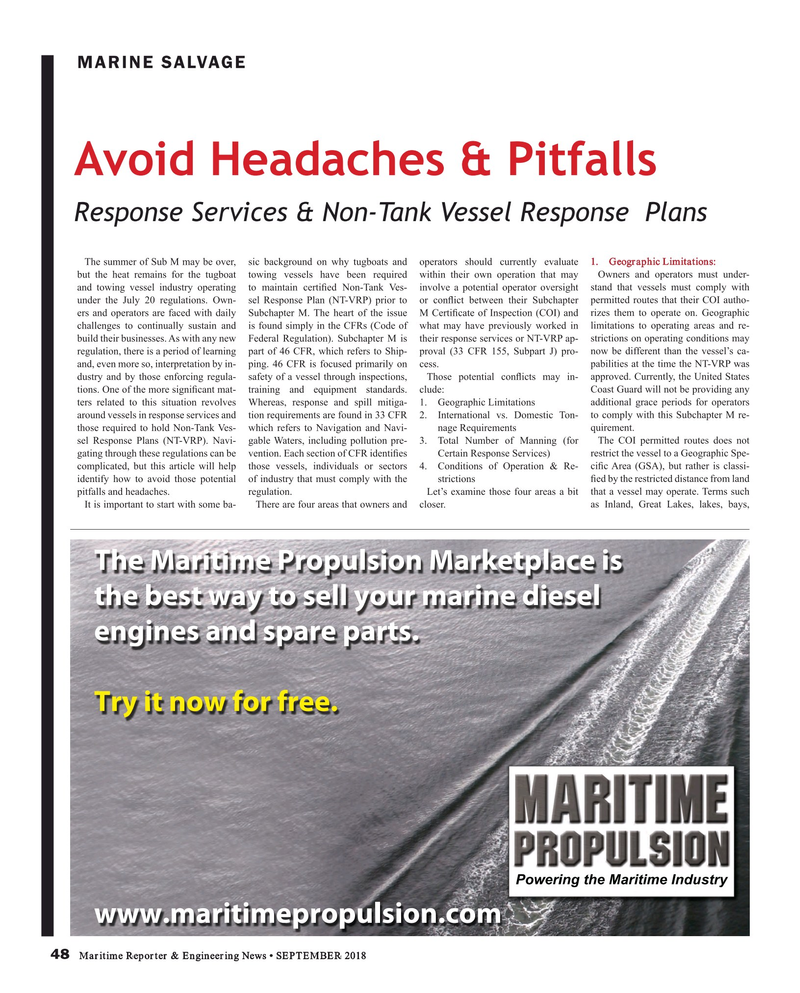
Page 48: of Maritime Reporter Magazine (September 2018)
Maritime Port & Ship Security
Read this page in Pdf, Flash or Html5 edition of September 2018 Maritime Reporter Magazine
MARINE SALVAGE
Avoid Headaches & Pitfalls
Response Services & Non-Tank Vessel Response Plans
The summer of Sub M may be over, sic background on why tugboats and operators should currently evaluate 1. Geographic Limitations: but the heat remains for the tugboat towing vessels have been required within their own operation that may Owners and operators must under- and towing vessel industry operating to maintain certi? ed Non-Tank Ves- involve a potential operator oversight stand that vessels must comply with under the July 20 regulations. Own- sel Response Plan (NT-VRP) prior to or con? ict between their Subchapter permitted routes that their COI autho- ers and operators are faced with daily Subchapter M. The heart of the issue M Certi? cate of Inspection (COI) and rizes them to operate on. Geographic challenges to continually sustain and is found simply in the CFRs (Code of what may have previously worked in limitations to operating areas and re- build their businesses. As with any new Federal Regulation). Subchapter M is their response services or NT-VRP ap- strictions on operating conditions may regulation, there is a period of learning part of 46 CFR, which refers to Ship- proval (33 CFR 155, Subpart J) pro- now be different than the vessel’s ca- and, even more so, interpretation by in- ping. 46 CFR is focused primarily on cess. pabilities at the time the NT-VRP was dustry and by those enforcing regula- safety of a vessel through inspections, Those potential con? icts may in- approved. Currently, the United States tions. One of the more signi? cant mat- training and equipment standards. clude: Coast Guard will not be providing any ters related to this situation revolves Whereas, response and spill mitiga- 1. Geographic Limitations additional grace periods for operators around vessels in response services and tion requirements are found in 33 CFR 2. International vs. Domestic Ton- to comply with this Subchapter M re- those required to hold Non-Tank Ves- which refers to Navigation and Navi- nage Requirements quirement. sel Response Plans (NT-VRP). Navi- gable Waters, including pollution pre- 3. Total Number of Manning (for The COI permitted routes does not gating through these regulations can be vention. Each section of CFR identi? es Certain Response Services) restrict the vessel to a Geographic Spe- complicated, but this article will help those vessels, individuals or sectors 4. Conditions of Operation & Re- ci? c Area (GSA), but rather is classi- identify how to avoid those potential of industry that must comply with the strictions ? ed by the restricted distance from land pitfalls and headaches. regulation. Let’s examine those four areas a bit that a vessel may operate. Terms such
It is important to start with some ba- There are four areas that owners and closer. as Inland, Great Lakes, lakes, bays, 48 Maritime Reporter & Engineering News • SEPTEMBER 2018
MR #9 (42-49).indd 48 MR #9 (42-49).indd 48 9/7/2018 9:50:36 AM9/7/2018 9:50:36 AM

 47
47

 49
49
